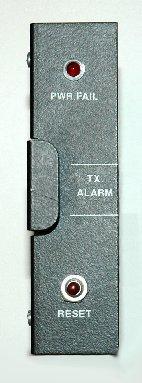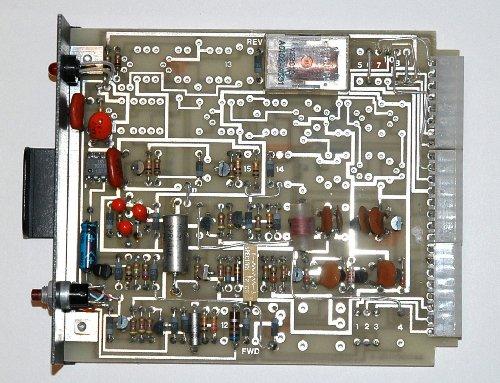Up two levels
Back to Home
Information supplied by Author Unknown
Text by Mike Morris WA6ILQ
|
Up one level Up two levels Back to Home |
The TLN6721CDX Alarm Card Information supplied by Author Unknown Text by Mike Morris WA6ILQ |
|


Photos by John Slusser WD7F
About 2002 the Canadian Provincial Police surplused out over 600 of their MSR-2000 repeaters - factory-built 136-150 MHz units that were installed in the 1980s. They still work beautifully on amateur 2m frequencies. The MSR-2000 control shelf is very much like a MICOR with one major difference: the edge connectors are of a more reliable type. Many of the MSR cards are idential to the equivalent MICOR card except for the edge connector and the fact that the MSR sheet metal panels are black with white silk screened lettering where the MICOR panels are raw aluminum with black silk screened lettering.
The standard MSR manuals are all you need to work on the RCMP hardware except for two cards: the TLN640CDX identifier card and the TLN6721CDX Alarm Card. The identifier card information was donated by Skipp May WV6F of Radio Properties Inc. (also known as RadioWrench) and is available on the MSR2000 page at this web site, but until recently the Alarm Card was terra incognita since it was a special design for the CPP project.
Well, someone came through with copies from one of the CPP shop manuals. The card outputs were connected into the CPP site alarm system that talked back to their dispatch center via the microwave backbone system. The site alarm system looked at door entry, interior temperature (both heat and cold), diesel fuel level, generator start, AC mains power, microwave link integrity (transmitter power out and receiver signal level in), etc. One of the site alarm inputs was from dry relay contacts on the MSR alarm card, which was set to trigger if the repeater transmitter power went below a minimum forward power level (the card has a trimpot adjustment to set that power level). This low power situation could be caused by output transistor failure, exciter failure or antenna SWR going so high it forced the power amplifier stage into safety shutdown (which could be caused by excessive ice on the antenna). Many of these sites are in remote locations... and dispatch might have to send some lucky soul out on a snowmobile or sno-cat in -40°C weather to fix the antenna... on top of a 400 foot tower.
Note that the card senses an analog DC voltage from a directional coupler placed in line with the antenna feedline to sense forward power. If you have a CPP repeater it will be there, if not you can use a Bird, Telewave or similar coupler or line section to generate the DC voltage.
By the way, you can use the card in a MICOR system if you change the edge connector.
The Files:
A four page PDF of the card info. Page 4
is a schematic. 2.06 MB PDF file. Yes, it starts on page 2-7 (in the middle
of the manual section on the plug-in cards), but the PDF contains all the docs that ever
existed on the card.
The schematic by itself. 115 kB GIF file. Extracted and cleaned up from the above PDF file.
Contact Information:
The author can be contacted at: his-callsign // at // repeater-builder // dot // com.
Back to the top of the page
Up one level (MSR index)
Up two levels (main Moto index)
Back to Home
Article text, artistic layout, text and hand-coded HTML © Copyright 2006 and date of last update by Mike Morris WA6ILQ.
This web page, this web site, the information presented in and on its pages and in these modifications and conversions is © Copyrighted 1995 and (date of last update) by Kevin Custer W3KKC and multiple originating authors. All Rights Reserved, including that of paper and web publication elsewhere.